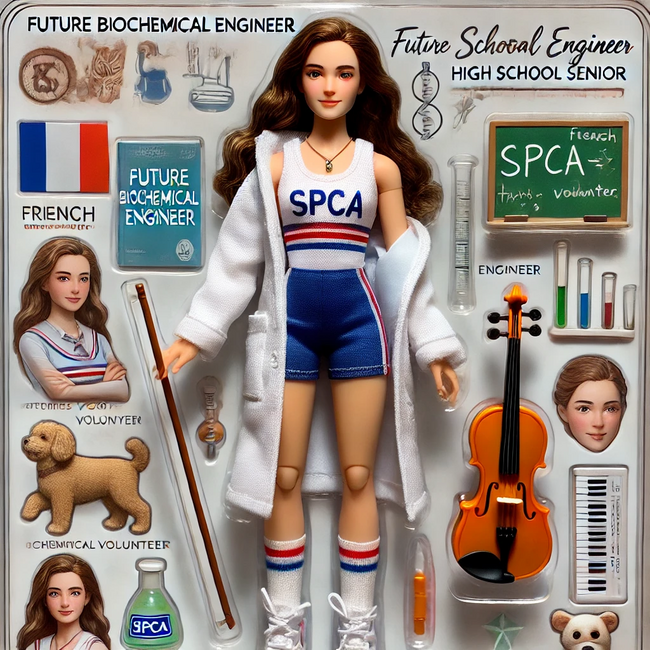You have /5 articles left.
Sign up for a free account or log in.

Courtesy of Brennan Barnard, generated by GPT-4o.
What if applying to college was actually fun? What if admission wasn’t approached as something applicants had to endure or survive, but rather seen as a time of opportunity and excitement? What if instead of students fixating on the achievement pressure and exceptionalism that is too often associated with applying to college, the application process sparked creativity and introspection? What if the experience truly encouraged applicants to consider who they are and what they want, not just how they can stand out or get ahead? What if college admission supported healthy risk-taking, failure and innovative thinking? What if the application felt less like a static form and more like an active canvas or storyboard?
At a time when there are calls for “merit-based admissions reform,” colleges and universities should seize the moment of disruption and reimagine what they ask for and how they assess applicants. Colleges that employ holistic admission are looking beyond just the numbers (GPA, class rank, test scores, etc.) at the different layers of an applicant—their unique strengths, interests and engagement in their community. They learn about these attributes in various ways through the application, from course choices and academic performance to extracurricular involvement, letters of recommendation and personal statements (the infamous college essay). All this creates a snapshot for the admission committee about the student, their potential to be successful and how they might contribute to the campus community.
This is the way it has been done for decades, and while applications have gone online and there have been other measured advances, the admission world generally has not embraced opportunities to think outside the box. Hopefully, the National Association for College Admission Counseling’s new Center for Reimagining College Access will push the envelope and encourage colleges to implement meaningful change.
In the meantime, what if we gave students more options to display their creativity and tell their stories in ways that were more personal, expressive and innovative? I am not advocating for the elimination of the college essay. In fact, I recently co-authored a book on the power of storytelling and college admission essays, so clearly I see the value. What I am suggesting is a menu of options for applicants to communicate their authentic narrative, in and out of the classroom, in more accessible ways. Here are some ideas.
Go Figure
There is a fun trend with newly accessible artificial intelligence tools where users can create action figures based on the unique features with which they prompt chat bots. You probably have seen them on social media: everyday people transformed into cartoon-like figures presented in toy packaging along with accessories. College applications could easily give instructions for students to prompt image generators to portray them as action figures based on their strengths, interests and involvement. It would provide reviewers with a visual representation of the applicant as they see themselves.
Tune In
Imagine if an applicant could compile documents, projects, presentations and other portfolio items and easily consolidate them into a unified message that highlights their experiences, accomplishments and qualifications. This is possible with a tool like Google’s NotebookLM’s Audio Overview. Almost instantly, students can create a podcast that provides a deep dive into what makes them unique. Admission officers could listen to a conversation about the applicant as they review all their other materials, allowing for a comprehensive picture of who the student is and how they might contribute intellectually and socially.
Show, Don’t Tell
Over the past decade, a few colleges and universities have experimented with allowing applicants to record short videos as supplements to their application. More recently InitialView’s Glimpse tool has been integrated directly into the admission application at more than 100 colleges, providing a way for students to record 60- to 90-second videos. Like it or not, this is the TikTok generation, and young people are accustomed to sending a message or making a video statement in about 60 seconds. What if every student could choose the video option as a way to show what they value and who they are? AI tools can create short videos and make compelling movie trailers that could tell an applicant’s story in innovative and concise ways as well. I made this rudimentary example in less than five minutes using the free Descript video generator.
Special Agents
Admission professionals often remind applicants that the application process is a human experience and that the individuals helping students navigate it have chosen this calling because they value this human connection. Unfortunately, the demands of the process and an increasing number of applications and responsibilities limit the bandwidth of admission staff to have more personal contact with applicants. In fact, many colleges and universities have abandoned interviews both because of issues of bias and the time and effort involved in offering these opportunities to all applicants.
Enter AI agents. Sal Khan is the founder of Khan Academy, Khan Lab School (where I work) and the free peer-to-peer tutoring platform Schoolhouse.world. He is also the author of Brave New Words: How AI Will Revolutionize Education (And Why That’s a Good Thing). He suggests that there are “less gameable, more interactive, more authentic” ways to assess students than subjective interviews, essays or recommendations, noting that “essays and recommendations were developed in a time when those were the only way, really, of being able to glean a little bit of personality, a little bit of context about someone.”
Khan proposes that applicants could, for example, engage in an ongoing conversation with an AI agent and even get feedback and have multiple opportunities to express themselves in a compelling way through which admission offices can get to know them. Or better yet, students could participate in moderated exchanges with peers. For the past year, Schoolhouse.world has piloted a civil Dialogues program that launched publicly last month. Students from all over the world are paired in one-on-one Zoom discussions on “important global topics like artificial intelligence, climate change and mental health.” As part of the program, participants receive a portfolio that can then be shared with colleges and universities to reveal more about their character and self-reflection; eight selective colleges have signed up so far to accept these portfolios as part of their application process.
Old Faithful
Of course, some students express themselves best using the written word, and by all means that should remain an option. Though some believe that AI has rendered the usefulness of college essays obsolete, not all agree. Among a menu of potential ways to tell one’s story, the essay can be effective and meaningful. Hopefully, colleges and universities will be more clear about their policies and expectations around the use of AI in preparing personal statements, as these tools can be powerful brainstorming partners and can increase access for those applicants who do not have support from counselors or coaches. This policy from Georgia Tech encouraging students to use AI to help brainstorm and refine their ideas is a clear and supportive example. Draconian approaches outlawing any AI support in an application only serve to confuse and concern students at an already anxious time.
A Menu of Options
When we talk with students about the college-searching and application experience, we often highlight that it should be about choices and options. There are so many great colleges in this nation, and rather than fixate on any specific college or subset of colleges, we encourage students to think broadly. The application should be no different: We should allow students the opportunity to express their voice and story in a way that best represents their style and strengths. Admission professionals should design the process with the user in mind, not just the institution. In an effort to develop a simple and streamlined experience, we risk stifling creativity and preventing students from expressing themselves in authentic and meaningful ways. It is time to expand the menu and meet students where they are.




